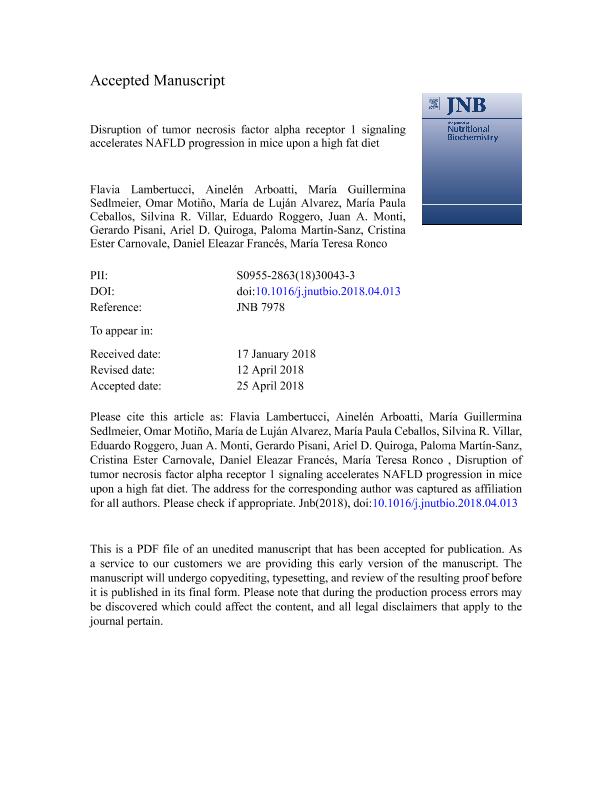Artículo
Disruption of tumor necrosis factor alpha receptor 1 signaling accelerates NAFLD progression in mice upon a high-fat diet
Lambertucci, Flavia ; Arboatti, Ainelén Soledad
; Arboatti, Ainelén Soledad ; Sedlmeier, María Guillermina; Motiño García-Miguel, Omar; Alvarez, María de Luján
; Sedlmeier, María Guillermina; Motiño García-Miguel, Omar; Alvarez, María de Luján ; Ceballos Mancini, María Paula
; Ceballos Mancini, María Paula ; Villar, Silvina Raquel
; Villar, Silvina Raquel ; Roggero, Eduardo Angel; Monti, Juan Alberto; Pisani, Gerardo; Quiroga, Ariel Dario
; Roggero, Eduardo Angel; Monti, Juan Alberto; Pisani, Gerardo; Quiroga, Ariel Dario ; Martin Sanz, Paloma; Carnovale, Cristina Ester
; Martin Sanz, Paloma; Carnovale, Cristina Ester ; Frances, Daniel Eleazar Antonio
; Frances, Daniel Eleazar Antonio ; Ronco, Maria Teresa
; Ronco, Maria Teresa
 ; Arboatti, Ainelén Soledad
; Arboatti, Ainelén Soledad ; Sedlmeier, María Guillermina; Motiño García-Miguel, Omar; Alvarez, María de Luján
; Sedlmeier, María Guillermina; Motiño García-Miguel, Omar; Alvarez, María de Luján ; Ceballos Mancini, María Paula
; Ceballos Mancini, María Paula ; Villar, Silvina Raquel
; Villar, Silvina Raquel ; Roggero, Eduardo Angel; Monti, Juan Alberto; Pisani, Gerardo; Quiroga, Ariel Dario
; Roggero, Eduardo Angel; Monti, Juan Alberto; Pisani, Gerardo; Quiroga, Ariel Dario ; Martin Sanz, Paloma; Carnovale, Cristina Ester
; Martin Sanz, Paloma; Carnovale, Cristina Ester ; Frances, Daniel Eleazar Antonio
; Frances, Daniel Eleazar Antonio ; Ronco, Maria Teresa
; Ronco, Maria Teresa
Fecha de publicación:
08/2018
Editorial:
Elsevier Science Inc
Revista:
Journal Of Nutritional Biochemistry
ISSN:
0955-2863
Idioma:
Inglés
Tipo de recurso:
Artículo publicado
Clasificación temática:
Resumen
Obesity is accompanied by a low-grade inflammation state, characterized by increased proinflammatory cytokines levels such as tumor necrosis factor alpha (TNFα) and interleukin-1 beta (IL-1β). In this regard, there exists a lack of studies in hepatic tissue about the role of TNFα receptor 1 (TNFR1) in the context of obesity and insulin resistance during the progression of nonalcoholic fatty liver disease (NAFLD). The aim of this work was to evaluate the effects of high-caloric feeding (HFD) (40% fat, for 16 weeks) on liver inflammation-induced apoptosis, insulin resistance, hepatic lipid accumulation and its progression toward nonalcoholic steatohepatitis (NASH) in TNFR1 knock-out and wild-type mice. Mechanisms involved in HFD-derived IL-1β release and impairment of insulin signaling are still unknown, so we determined whether IL-1β affects liver insulin sensitivity and apoptosis through TNFα receptor 1 (TNFR1)-dependent pathways. We showed that knocking out TNFR1 induces an enhanced IL-1β plasmatic release upon HFD feed. This was correlated with higher hepatic and epididymal white adipose tissue mRNA levels. In vivo and in vitro assays confirmed an impairment in hepatic insulin signaling, in part due to IL-1β-induced decrease of AKT activation and diminution of IRS1 levels, followed by an increase in inflammation, macrophage (resident and recruited) accumulation, hepatocyte apoptotic process and finally hepatic damage. In addition, TNFR1 KO mice displayed higher levels of pro-fibrogenic markers. TNFR1 signaling disruption upon an HFD leads to an accelerated progression from simple steatosis to a more severe phenotype with many NASH features, pointing out a key role of TNFR1 in NAFLD progression.
Archivos asociados
Licencia
Identificadores
Colecciones
Articulos(IDICER)
Articulos de INSTITUTO DE INMUNOLOGIA CLINICA Y EXPERIMENTAL DE ROSARIO
Articulos de INSTITUTO DE INMUNOLOGIA CLINICA Y EXPERIMENTAL DE ROSARIO
Articulos(IFISE)
Articulos de INST.DE FISIOLOGIA EXPERIMENTAL (I)
Articulos de INST.DE FISIOLOGIA EXPERIMENTAL (I)
Citación
Lambertucci, Flavia; Arboatti, Ainelén Soledad; Sedlmeier, María Guillermina; Motiño García-Miguel, Omar; Alvarez, María de Luján; et al.; Disruption of tumor necrosis factor alpha receptor 1 signaling accelerates NAFLD progression in mice upon a high-fat diet; Elsevier Science Inc; Journal Of Nutritional Biochemistry; 58; 8-2018; 17-27
Compartir
Altmétricas



